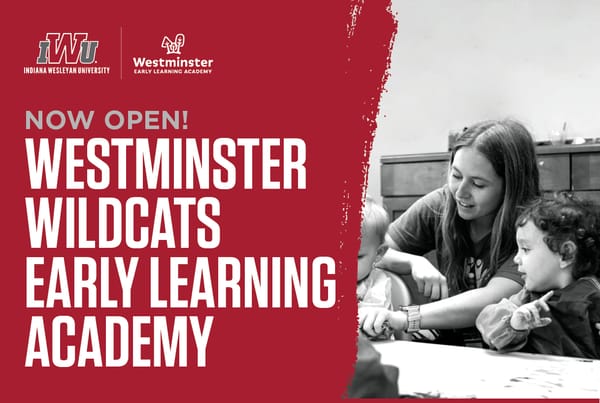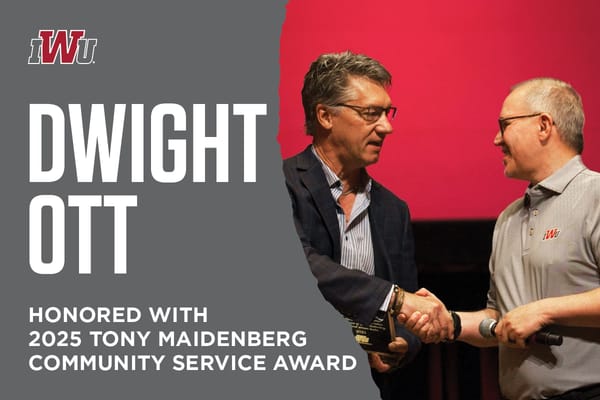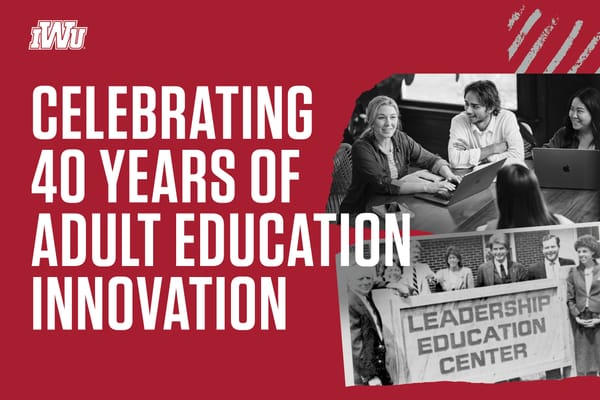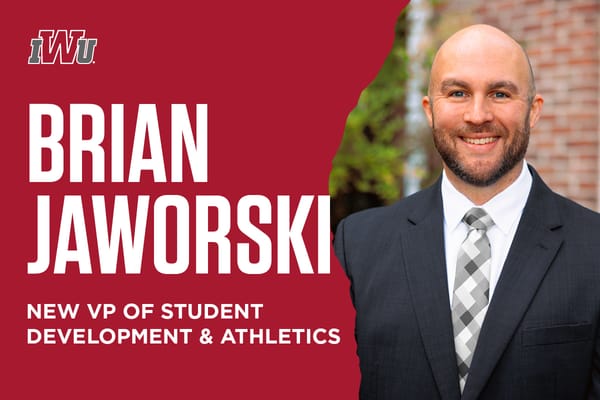Presidents of the Past—Woodrow I. Goodman (1960-1976)

A Program of Progress
Born in eastern Kentucky and raised in southern Ohio, Woodrow I. Goodman was the son of a Pilgrim Holiness minister. Goodman arrived at Marion College at the age of sixteen, entering college at an early age. During this time, he waited tables in Teter’s dining hall and assisted in the physics lab as his means of income while on campus. Woodrow Goodman was also very engaged in student life, serving as part of YMWB, Marion College Choir, the Athenian Forensic Club, the Buckeye Club, the Easterners Club, the Inter-Society Council, the debate team, and as president of the Eureka Literary Club, both his freshman and sophomore classes, and Marion College’s first Student Council, helping to establish it in 1938 before graduating the following year with a Bachelor of Arts and a Bachelor of Science in Education. According to Goodman’s predecessor, President McConn, “during his days on the campus [Goodman] participated in every phase of school life.”
After graduation, Goodman engaged in international travel, visiting Egypt, Italy, Lebanon, Syria, Jordan, Israel, Greece, Switzerland, and England. He also became the youngest college president in the United States as the founding president of Bethel College—a job he acquired during graduate school. In 1951, Goodman returned to Marion College for a few days to serve as the Homecoming speaker, at which point President McConn was impressed by him.
When McConn announced his intention to retire in 1958, the search for his successor began. First, Marion College attempted to hire Dr. Harold K. Sheets as the new president, Sheets accepting the position in 1958 with the intention of starting in 1960. June of 1959, however, brought news of Sheets’ election as one of three general superintendents within the Wesleyan Church, prompting a new search. Given Goodman was already well thought of by everyone at Marion College who knew him, it was perhaps unsurprising he was soon selected as the next candidate. By this point, Woodrow and Marie Goodman were married with three children, much having changed over the course of the last several years, but when asked on October 15th, 1959 if he would like to take on the presidency, it took him a little over a week to accept. On the 23rd, Goodman was secured as the next president of Marion College.
While his presidency didn’t start until July 1st of the following year, by the 15th Goodman was introducing his “Program of Progress”. The “Program of Progress” initiated by Goodman prompted extensive self-study programs and curricular changes, as well as acquisition of land and construction projects. The program emphasized five specific areas: institutional self-studies, adjustments in keeping with those studies, goals for annual growth in line with self-studies, development of a master plan for the decade, and organization of a major campaign for financial support. Although he became president in 1960, Goodman’s official inauguration didn’t occur until October 14th of the following year. At the event, former president McConn spoke, saying, “May God give you strength for your tasks, wisdom for your problems, and the wholehearted cooperation of the college and her constituency for the strenuous days ahead.”
While McConn sought accreditation for Marion College for many years, it remained the one issue he was unable to solve by the end of his almost thirty-year-long presidency. As such, when Goodman arrived, it was something he picked up the responsibility of and began to pour time and effort into achieving. He believed the key to obtaining accreditation was making Marion College an excellent university in every manner. He later stated, “the key mood for this formative period was change; a dynamic change from satisfaction with the status quo to feverish activity for institutional improvement.”
In 1966, after six years of efforts, Goodman decided it was time to invite the North Central Association of Colleges and Secondary Schools back for a review. This time, accreditation was given. “It was the favorable conclusion of a long hard task;” Goodman mused, “to God be the praise for his wisdom, strength, and blessing on the cooperative efforts of the trustees, faculty, students, alumni, community, and church.”
During this same time, Goodman constructed a new library, with the old one soon converted into a campus center. Further construction efforts included Burnes Hall, which began construction in 1967 with grant money and ended in 1969. Goodman’s personal life was to undergo a drastic change between the start of this project and its conclusion, however.
In 1968, a large deposit of oil was discovered beneath the president’s house. This was a very positive revelation for the college, and yet it also included the downside of requiring the instillation of a drilling rig, with its location blocking the house’s driveway. As this was less than ideal, Marion College informed the community that, “In view of the fact that Marion College’s Program of Progress has not yet been completed and the construction of the Science Building has not yet begun, MC can not afford to lose the services of Dr. Goodman for the four years that his driveway will be blocked.”
As a result of this, the Goodman family moved into Ott House, after some minor renovations were completed to make it more suitable for Goodman and his family to call home. While the entire situation caused a great deal of inconvenience for President Goodman and his family, both the president and the entire rest of the school were glad for the unexpected financial opportunities it opened.
This same year, the Wesleyan Church merged with the Pilgrim Holiness Church, the same church Goodman’s father served as a pastor in. Because both denominations ran their own separate academic institutions, many of these were merged, with one of the Pilgrim Holiness Church’s colleges, Owosso, supposedly merging with Marion College. In reality they stayed separate from each other in every meaningful way, with Goodman becoming president of both, as Marion College did increasingly well and Owosso limped along with increasing slowness. Two years later, on June 1st, 1970, Owosso was sold and separated from Marion College to everyone’s satisfaction, allowing Goodman to focus all of his attention on Marion College once more. The individual who purchased the school, however, ended up running his own new college, the “John Wesley College” just long enough to secure money from a variety of individuals and organizations, before closing abruptly with most promises left unfulfilled—to students, backers, and Marion College.
In addition, 1968 was also the year Marion College broke into intercollegiate athletics, switching out the Amphics and Eurekans as the mascots of Marion College for the Titans. Bowman Hall was also added at this same time and contained enough rooms to house 112 women plus its residential director. Around the time Burnes Hall finished construction, Goodman began another construction project, which would become the Baldwin Dining Center—built to seat 650 people and arranged to accommodate six separate functions at once. While there was a dining hall option at the time, the school’s growth over the span of many years resulted in it becoming small and cramped, forcing it to expand.
The year 1972 also brought with it several notable events—President Goodman reported enrollment was declining by 10%, resulting in a cut of $175,000 from the school’s budget. At the same time, the college applied for a two-year grant to support a nursing education major. While nursing was not a field the college possessed much experience in, it was believed Marion College should invest at least some time and money into starting such a program, as it offered the potential to bring in a respectable number of students. After four lengthy years, President Goodman and his family were able to move back into their home at last.
Early the following year, in 1973, Goodman launched Project Faith—a new initiative to secure prayer support, names of contributors, and additional help. He knew God would provide for the college, even if it appeared in decline. Costs once again began to climb during the 1973-1974 academic year, and Goodman later stated this crisis “began to affect me personally. For about three weeks in late May and early June I had the uneasy feeling of sliding toward a precipice without any visible means of stopping the slide. There were nights that I lost a lot of sleep which was very unusual for me. All the major signs of a nervous breakdown began to appear. I was conscious of them but felt helpless to correct them. Then one Sunday afternoon while lying on my bed resting I cried out to the Lord and He heard me and I felt a definite touch on my body. From that point on I was better physically and more confident that the Lord had a way out, though I did not know how.”
At the end of the 1973-1974 academic year, Goodman announced his intention to retire in two years’ time. The financial crisis continued throughout 1974, as many small universities found themselves struggling. In 1975, however, the school’s fortunes once again improved, becoming much more positive for the second half of the 1974-1975 academic year and for the entirety of the 1975-1976 academic year. While this time of crisis came and went over a short period in the grand scheme of things, and while Goodman faced many challenges and overcame them during his presidency, it is perhaps fair to say after sixteen years in office as Marion College’s president, and even longer in higher education as a whole, Goodman was worn out, and needed to rest. He stated at one point, “Within two or three years I foresee the need of Marion College to have a leadership capable of planning and implementing a program of institutional development over a period of fifteen to twenty years.” Knowing he could not sustain two more decades as president even if he wanted to, he chose to leave the position in order to usher in a new era.
Throughout his presidency, Dr. Goodman was responsible for the construction or refurbishing of a variety of buildings all across campus, with Shatford, Bowman, Baldwin, Burnes, and the library all being created during his presidency. The long-sought-after accreditation from the NCA was also achieved, enrollment more than doubled from 420 to 849 students, the annual budget rose from $360,000 in Goodman’s first year to $2,500,000 in his last, and student aid grew from a few thousand dollars to over a million every year. Programs in nursing, criminal justice, and economic business were added as well as new majors in sociology, political science, art, physical education, and journalism. Furthermore, intercollegiate athletics were added and began to thrive. By the time President Goodman departed, the total value of the campus was $4,000,000.
When he left Marion College for the last time on May 7th, 1976, more than two hundred people attended his departure. The recently constructed library was renamed in honor of him as the Woodrow Goodman Library (now Goodman Hall), and May 16th was designated by Mayor of Marion Anthony C. Maidenberg as “Dr. Woodrow Goodman Day”.
Following his retirement, Woodrow and Marie Goodman moved to northern Marion for a few years before settling in California. Even though they were so far from Marion College at this point, the school still represented a large part of their lives—over four decades, for Woodrow—and as such they stayed connected. Over the years which followed, the couple continued to update the alumni office about various gardening projects and trips they went on. They grew a garden in their backyard, full of peaches, grapefruit, lemons, and plums, and in the waning years of their lives tended to this garden as though it was their entire world.
In his autobiography, written during these late days of his life, Woodrow Goodman reflected on his time at Marion College and his life in general. “Like the dream of a bridge over the valley, my life did not unfold exactly as my daydreams envisioned. Nevertheless, the various dreams had a common core that was real, a service motive. The dreams provided a motivation that enabled me to build bridges over several valleys during my days of service to God and man.”
Want to read more? Check out the other articles in the "President's of the Past" series!
- Henry C. Bedford (1919-1922)
- John W. Leedy (1922-1927)
- The Forgotten Presidents (1927-1932)
- William F. McConn (1932-1960)
- Woodrow I. Goodman (1960-1976)
- Robert R. Luckey (1976-1984, 1986-1987)
- James P. Hill Jr. (1984-1986)
- James B. Barnes (1987-2006)
- Henry L. Smith (2006-2013)
- David W. Wright (2013-2022)





